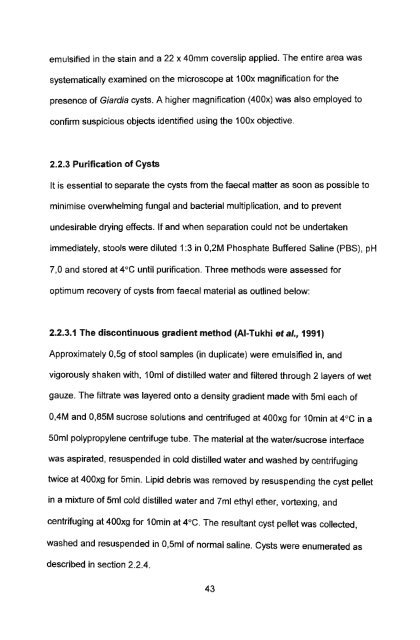in vitro culture and isoenzyme analysis of giardia lamblia
in vitro culture and isoenzyme analysis of giardia lamblia
in vitro culture and isoenzyme analysis of giardia lamblia
Create successful ePaper yourself
Turn your PDF publications into a flip-book with our unique Google optimized e-Paper software.
emulsified <strong>in</strong> the sta<strong>in</strong> <strong>and</strong> a 22 x 40mm coverslip applied. The entire area was<br />
systematically exam<strong>in</strong>ed on the microscope at 100x magnification for the<br />
presence <strong>of</strong> Giardia cysts. A higher magnification (400x) was also employed to<br />
confirm suspicious objects identified us<strong>in</strong>g the 100x objective.<br />
2.2.3 Purification <strong>of</strong> Cysts<br />
It is essential to separate the cysts from the faecal matter as soon as possible to<br />
m<strong>in</strong>imise overwhelm<strong>in</strong>g fungal <strong>and</strong> bacterial multiplication, <strong>and</strong> to prevent<br />
undesirable dry<strong>in</strong>g effects. If <strong>and</strong> when separation could not be undertaken<br />
immediately, stools were diluted 1:3 <strong>in</strong> O,2M Phosphate Buffered Sal<strong>in</strong>e (PBS),. pH<br />
7,0 <strong>and</strong> stored at 4°C until purification. Three methods were assessed for<br />
optimum recovery <strong>of</strong> cysts from faecal material as outl<strong>in</strong>ed below:<br />
2.2.3.1 The discont<strong>in</strong>uous gradient method (AI-Tukhi et al., 1991)<br />
Approximately O,5g <strong>of</strong> stool samples (<strong>in</strong> duplicate) were emulsified <strong>in</strong>, <strong>and</strong><br />
vigorously shaken with, 10ml <strong>of</strong> distilled water <strong>and</strong> filtered through 2 layers <strong>of</strong> wet<br />
gauze. The filtrate was layered onto a density gradient made with 5ml each <strong>of</strong><br />
O,4M <strong>and</strong> O,85M sucrose solutions <strong>and</strong> centrifuged at 400xg for 10m<strong>in</strong> at 4°C <strong>in</strong> a<br />
50ml polypropylene centrifuge tube. The material at the water/sucrose <strong>in</strong>terface<br />
was aspirated, resuspended <strong>in</strong> cold distilled water <strong>and</strong> washed by centrifug<strong>in</strong>g<br />
twice at 400xg for 5m<strong>in</strong>. Lipid debris was removed by resuspend<strong>in</strong>g the cyst pellet<br />
<strong>in</strong> a mixture <strong>of</strong> 5ml cold distilled water <strong>and</strong> 7ml ethyl ether, vortex<strong>in</strong>g, <strong>and</strong><br />
centrifug<strong>in</strong>g at 400xg for 10m<strong>in</strong> at 4°C. The resultant cyst pellet was collected,<br />
washed <strong>and</strong> resuspended <strong>in</strong> O,5ml <strong>of</strong> normal sal<strong>in</strong>e. Cysts were enumerated as<br />
described <strong>in</strong> section 2.2.4.<br />
43
















